Danyang Zhang
Is GPT-OSS All You Need? Benchmarking Large Language Models for Financial Intelligence and the Surprising Efficiency Paradox
Dec 09, 2025Abstract:The rapid adoption of large language models in financial services necessitates rigorous evaluation frameworks to assess their performance, efficiency, and practical applicability. This paper conducts a comprehensive evaluation of the GPT-OSS model family alongside contemporary LLMs across ten diverse financial NLP tasks. Through extensive experimentation on 120B and 20B parameter variants of GPT-OSS, we reveal a counterintuitive finding: the smaller GPT-OSS-20B model achieves comparable accuracy (65.1% vs 66.5%) while demonstrating superior computational efficiency with 198.4 Token Efficiency Score and 159.80 tokens per second processing speed [1]. Our evaluation encompasses sentiment analysis, question answering, and entity recognition tasks using real-world financial datasets including Financial PhraseBank, FiQA-SA, and FLARE FINERORD. We introduce novel efficiency metrics that capture the trade-off between model performance and resource utilization, providing critical insights for deployment decisions in production environments. The benchmark reveals that GPT-OSS models consistently outperform larger competitors including Qwen3-235B, challenging the prevailing assumption that model scale directly correlates with task performance [2]. Our findings demonstrate that architectural innovations and training strategies in GPT-OSS enable smaller models to achieve competitive performance with significantly reduced computational overhead, offering a pathway toward sustainable and cost-effective deployment of LLMs in financial applications.
Kunlun Anomaly Troubleshooter: Enabling Kernel-Level Anomaly Detection and Causal Reasoning for Large Model Distributed Inference
Nov 08, 2025Abstract:Anomaly troubleshooting for large model distributed inference (LMDI) remains a critical challenge. Resolving anomalies such as inference performance degradation or latency jitter in distributed system demands significant manual efforts from domain experts, resulting in extremely time-consuming diagnosis processes with relatively low accuracy. In this paper, we introduce Kunlun Anomaly Troubleshooter (KAT), the first anomaly troubleshooting framework tailored for LMDI. KAT addresses this problem through two core innovations. First, KAT exploits the synchronicity and consistency of GPU workers, innovatively leverages function trace data to precisely detect kernel-level anomalies and associated hardware components at nanosecond resolution. Second, KAT integrates these detection results into a domain-adapted LLM, delivering systematic causal reasoning and natural language interpretation of complex anomaly symptoms. Evaluations conducted in Alibaba Cloud Service production environment indicate that KAT achieves over 0.884 precision and 0.936 recall in anomaly detection, providing detail anomaly insights that significantly narrow down the diagnostic scope and improve both the efficiency and success rate of troubleshooting.
Is GPT-OSS Good? A Comprehensive Evaluation of OpenAI's Latest Open Source Models
Aug 17, 2025



Abstract:In August 2025, OpenAI released GPT-OSS models, its first open weight large language models since GPT-2 in 2019, comprising two mixture of experts architectures with 120B and 20B parameters. We evaluated both variants against six contemporary open source large language models ranging from 14.7B to 235B parameters, representing both dense and sparse designs, across ten benchmarks covering general knowledge, mathematical reasoning, code generation, multilingual understanding, and conversational ability. All models were tested in unquantised form under standardised inference settings, with statistical validation using McNemars test and effect size analysis. Results show that gpt-oss-20B consistently outperforms gpt-oss-120B on several benchmarks, such as HumanEval and MMLU, despite requiring substantially less memory and energy per response. Both models demonstrate mid-tier overall performance within the current open source landscape, with relative strength in code generation and notable weaknesses in multilingual tasks. These findings provide empirical evidence that scaling in sparse architectures may not yield proportional performance gains, underscoring the need for further investigation into optimisation strategies and informing more efficient model selection for future open source deployments.
OpenCUA: Open Foundations for Computer-Use Agents
Aug 12, 2025Abstract:Vision-language models have demonstrated impressive capabilities as computer-use agents (CUAs) capable of automating diverse computer tasks. As their commercial potential grows, critical details of the most capable CUA systems remain closed. As these agents will increasingly mediate digital interactions and execute consequential decisions on our behalf, the research community needs access to open CUA frameworks to study their capabilities, limitations, and risks. To bridge this gap, we propose OpenCUA, a comprehensive open-source framework for scaling CUA data and foundation models. Our framework consists of: (1) an annotation infrastructure that seamlessly captures human computer-use demonstrations; (2) AgentNet, the first large-scale computer-use task dataset spanning 3 operating systems and 200+ applications and websites; (3) a scalable pipeline that transforms demonstrations into state-action pairs with reflective long Chain-of-Thought reasoning that sustain robust performance gains as data scales. Our end-to-end agent models demonstrate strong performance across CUA benchmarks. In particular, OpenCUA-32B achieves an average success rate of 34.8% on OSWorld-Verified, establishing a new state-of-the-art (SOTA) among open-source models and surpassing OpenAI CUA (GPT-4o). Further analysis confirms that our approach generalizes well across domains and benefits significantly from increased test-time computation. We release our annotation tool, datasets, code, and models to build open foundations for further CUA research.
ChemDFM-R: An Chemical Reasoner LLM Enhanced with Atomized Chemical Knowledge
Jul 30, 2025Abstract:While large language models (LLMs) have achieved impressive progress, their application in scientific domains such as chemistry remains hindered by shallow domain understanding and limited reasoning capabilities. In this work, we focus on the specific field of chemistry and develop a Chemical Reasoner LLM, ChemDFM-R. We first construct a comprehensive dataset of atomized knowledge points to enhance the model's understanding of the fundamental principles and logical structure of chemistry. Then, we propose a mix-sourced distillation strategy that integrates expert-curated knowledge with general-domain reasoning skills, followed by domain-specific reinforcement learning to enhance chemical reasoning. Experiments on diverse chemical benchmarks demonstrate that ChemDFM-R achieves cutting-edge performance while providing interpretable, rationale-driven outputs. Further case studies illustrate how explicit reasoning chains significantly improve the reliability, transparency, and practical utility of the model in real-world human-AI collaboration scenarios.
ProgRM: Build Better GUI Agents with Progress Rewards
May 23, 2025Abstract:LLM-based (Large Language Model) GUI (Graphical User Interface) agents can potentially reshape our daily lives significantly. However, current LLM-based GUI agents suffer from the scarcity of high-quality training data owing to the difficulties of trajectory collection and reward annotation. Existing works have been exploring LLMs to collect trajectories for imitation learning or to offer reward signals for online RL training. However, the Outcome Reward Model (ORM) used in existing works cannot provide finegrained feedback and can over-penalize the valuable steps in finally failed trajectories. To this end, we propose Progress Reward Model (ProgRM) to provide dense informative intermediate rewards by predicting a task completion progress for each step in online training. To handle the challenge of progress reward label annotation, we further design an efficient LCS-based (Longest Common Subsequence) self-annotation algorithm to discover the key steps in trajectories and assign progress labels accordingly. ProgRM is evaluated with extensive experiments and analyses. Actors trained with ProgRM outperform leading proprietary LLMs and ORM-trained actors, illustrating the effectiveness of ProgRM. The codes for experiments will be made publicly available upon acceptance.
Spider2-V: How Far Are Multimodal Agents From Automating Data Science and Engineering Workflows?
Jul 15, 2024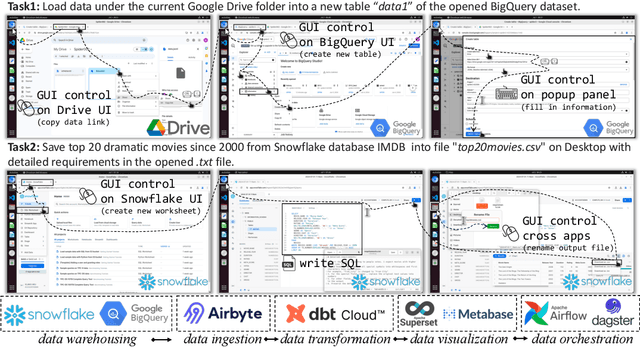
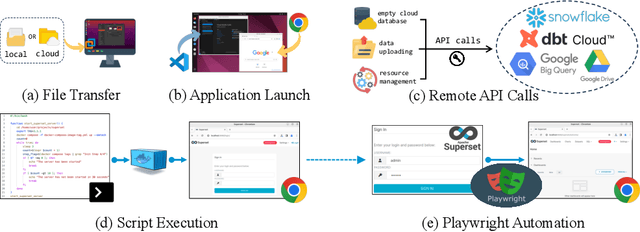
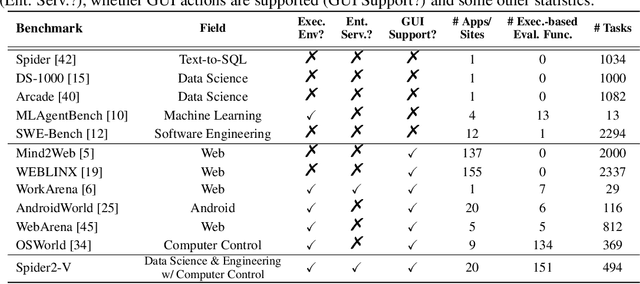
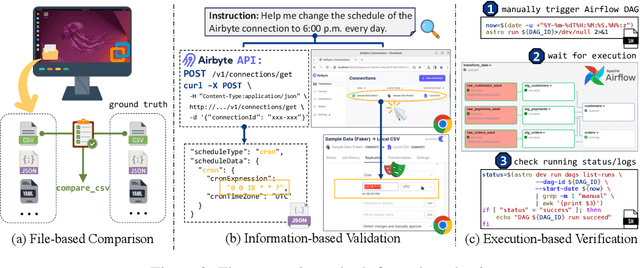
Abstract:Data science and engineering workflows often span multiple stages, from warehousing to orchestration, using tools like BigQuery, dbt, and Airbyte. As vision language models (VLMs) advance in multimodal understanding and code generation, VLM-based agents could potentially automate these workflows by generating SQL queries, Python code, and GUI operations. This automation can improve the productivity of experts while democratizing access to large-scale data analysis. In this paper, we introduce Spider2-V, the first multimodal agent benchmark focusing on professional data science and engineering workflows, featuring 494 real-world tasks in authentic computer environments and incorporating 20 enterprise-level professional applications. These tasks, derived from real-world use cases, evaluate the ability of a multimodal agent to perform data-related tasks by writing code and managing the GUI in enterprise data software systems. To balance realistic simulation with evaluation simplicity, we devote significant effort to developing automatic configurations for task setup and carefully crafting evaluation metrics for each task. Furthermore, we supplement multimodal agents with comprehensive documents of these enterprise data software systems. Our empirical evaluation reveals that existing state-of-the-art LLM/VLM-based agents do not reliably automate full data workflows (14.0% success). Even with step-by-step guidance, these agents still underperform in tasks that require fine-grained, knowledge-intensive GUI actions (16.2%) and involve remote cloud-hosted workspaces (10.6%). We hope that Spider2-V paves the way for autonomous multimodal agents to transform the automation of data science and engineering workflow. Our code and data are available at https://spider2-v.github.io.
OSWorld: Benchmarking Multimodal Agents for Open-Ended Tasks in Real Computer Environments
Apr 11, 2024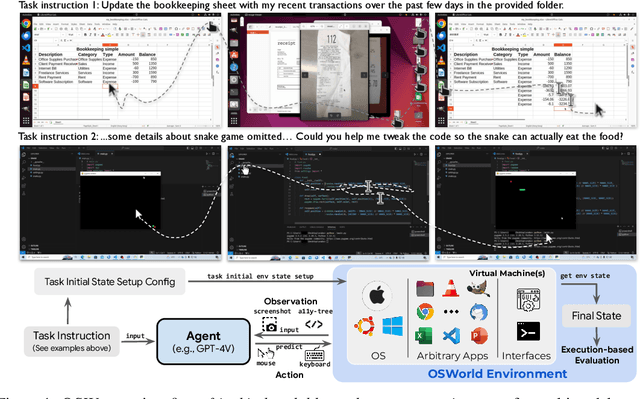
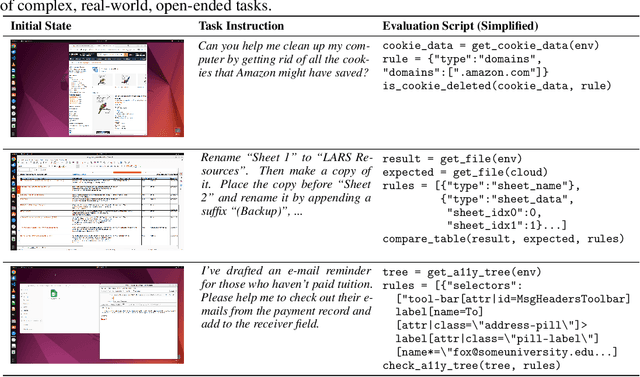
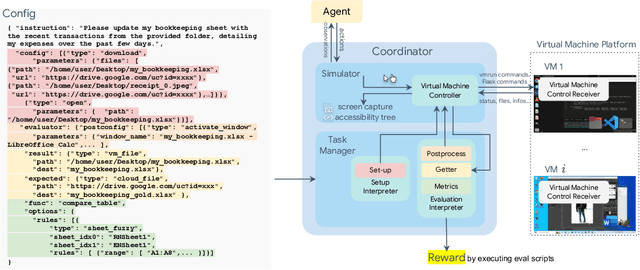
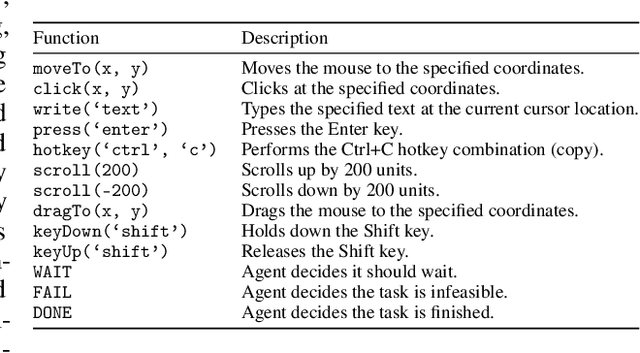
Abstract:Autonomous agents that accomplish complex computer tasks with minimal human interventions have the potential to transform human-computer interaction, significantly enhancing accessibility and productivity. However, existing benchmarks either lack an interactive environment or are limited to environments specific to certain applications or domains, failing to reflect the diverse and complex nature of real-world computer use, thereby limiting the scope of tasks and agent scalability. To address this issue, we introduce OSWorld, the first-of-its-kind scalable, real computer environment for multimodal agents, supporting task setup, execution-based evaluation, and interactive learning across various operating systems such as Ubuntu, Windows, and macOS. OSWorld can serve as a unified, integrated computer environment for assessing open-ended computer tasks that involve arbitrary applications. Building upon OSWorld, we create a benchmark of 369 computer tasks involving real web and desktop apps in open domains, OS file I/O, and workflows spanning multiple applications. Each task example is derived from real-world computer use cases and includes a detailed initial state setup configuration and a custom execution-based evaluation script for reliable, reproducible evaluation. Extensive evaluation of state-of-the-art LLM/VLM-based agents on OSWorld reveals significant deficiencies in their ability to serve as computer assistants. While humans can accomplish over 72.36% of the tasks, the best model achieves only 12.24% success, primarily struggling with GUI grounding and operational knowledge. Comprehensive analysis using OSWorld provides valuable insights for developing multimodal generalist agents that were not possible with previous benchmarks. Our code, environment, baseline models, and data are publicly available at https://os-world.github.io.
Large Language Model Is Semi-Parametric Reinforcement Learning Agent
Jun 09, 2023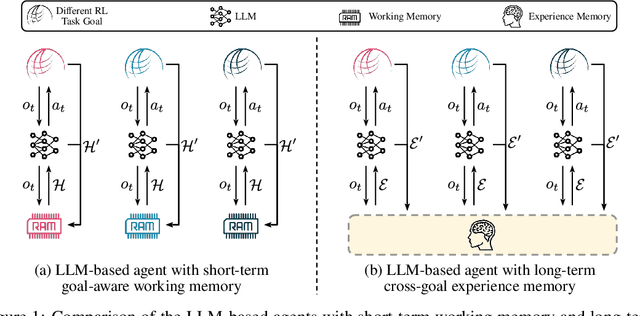
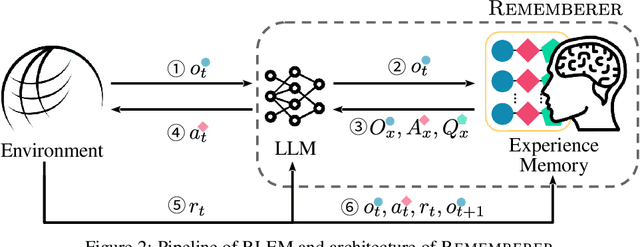

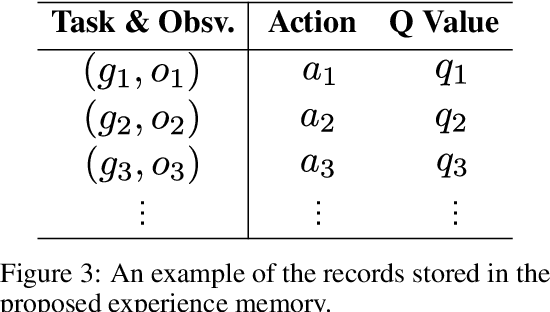
Abstract:Inspired by the insights in cognitive science with respect to human memory and reasoning mechanism, a novel evolvable LLM-based (Large Language Model) agent framework is proposed as REMEMBERER. By equipping the LLM with a long-term experience memory, REMEMBERER is capable of exploiting the experiences from the past episodes even for different task goals, which excels an LLM-based agent with fixed exemplars or equipped with a transient working memory. We further introduce Reinforcement Learning with Experience Memory (RLEM) to update the memory. Thus, the whole system can learn from the experiences of both success and failure, and evolve its capability without fine-tuning the parameters of the LLM. In this way, the proposed REMEMBERER constitutes a semi-parametric RL agent. Extensive experiments are conducted on two RL task sets to evaluate the proposed framework. The average results with different initialization and training sets exceed the prior SOTA by 4% and 2% for the success rate on two task sets and demonstrate the superiority and robustness of REMEMBERER.
Mobile-Env: A Universal Platform for Training and Evaluation of Mobile Interaction
May 14, 2023
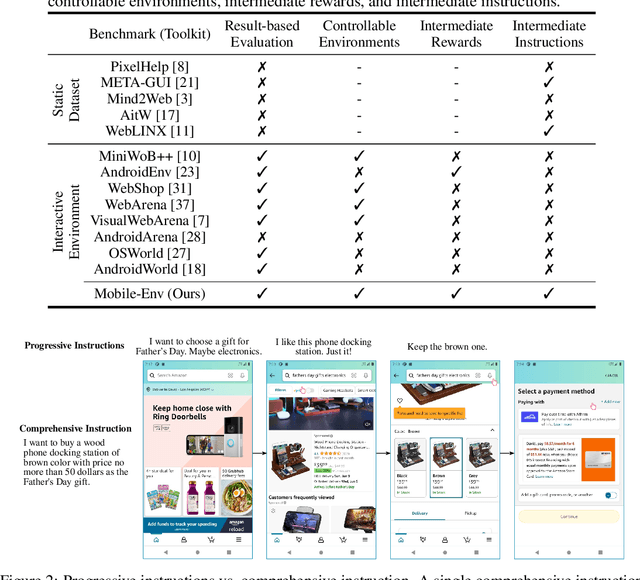

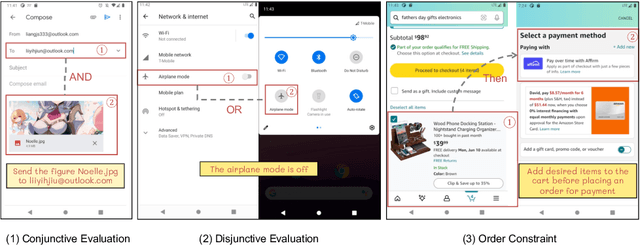
Abstract:The interaction platform plays a crucial role in the recent advancement of the control and decision domains like game playing and embodied intelligence. However, there is still a lack of a satisfactory platform for the information user interface (InfoUI) interaction. The proposed InfoUI comprises not only the plain text information, but the multimodal contents and a few spatial structures with styles as well. To help the research of InfoUI interaction, a novel platform Mobile-Env is presented in this paper. The Mobile-Env platform is designed to be flexible, adaptable, and easily-extended. Based on Mobile-Env, an InfoUI task set is then built for a demonstration and evaluation. An agent based on the large-scale language model (LLM) is tested on the task set. The experiment results demonstrate the great potential of the LLM to do text understanding and matching and, meanwhile, reveal the necessity of a better mechanism of interaction feedback and exploration. Several new discussions are conducted as well. A demo video is available at https://youtu.be/gKV6KZYwxGY. The code repository is available at https://github.com/X-LANCE/Mobile-Env. The proposed WikiHow task set is made public at https://huggingface.co/datasets/zdy023/WikiHow-taskset.
 Add to Chrome
Add to Chrome Add to Firefox
Add to Firefox Add to Edge
Add to Edge